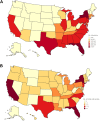Reducing Health Care Disparities in Sickle Cell Disease: A Review
- PMID: 31600481
- PMCID: PMC6832089
- DOI: 10.1177/0033354919881438
Reducing Health Care Disparities in Sickle Cell Disease: A Review
Abstract
Sickle cell disease (SCD) is an inherited blood disorder most common among African American and Hispanic American persons. The disease can cause substantial, long-term, and costly health problems, including infections, stroke, and kidney failure, many of which can reduce life expectancy. Disparities in receiving health care among African Americans and other racial/ethnic minority groups in the United States are well known and directly related to poor outcomes associated with SCD. As an orphan disease-one that affects <200 000 persons nationwide-SCD does not receive the research funding and pharmaceutical investment directed to other orphan diseases. For example, cystic fibrosis affects fewer than half the number of persons but receives 3.5 times the funding from the National Institutes of Health and 440 times the funding from national foundations. In this review, we discuss the health inequities affecting persons with SCD, describe programs intended to improve their care, and identify actions that could be taken to further reduce these inequities, improve care, control treatment costs, and ease the burden of disease.
Keywords: Medicaid; access to care; community health centers; health care disparities; sickle cell disease.
Conflict of interest statement
Figures


References
-
- Hassell KL. Population estimates of sickle cell disease in the U.S. Am J Prev Med. 2010;38(suppl 4):S512–S521. doi:10.1016/j.amepre.2009.12.022 - PubMed
-
- Piel FB, Steinberg MH, Rees DC. Sickle cell disease. N Engl J Med. 2017;376(16):1561–1573. doi:10.1056/NEJMra1510865 - PubMed
-
- Hamideh D, Alvarez O. Sickle cell disease related mortality in the United States (1999-2009). Pediatr Blood Cancer. 2013;60(9):1482–1486. doi:10.1002/pbc.24557 - PubMed
-
- Platt OS, Brambilla DJ, Rosse WF, et al. Mortality in sickle cell disease: life expectancy and risk factors for early death. N Engl J Med. 1994;330(23):1639–1644. doi:10.1056/NEJM199406093302303 - PubMed
Publication types
MeSH terms
LinkOut - more resources
Full Text Sources
Medical
Research Materials

